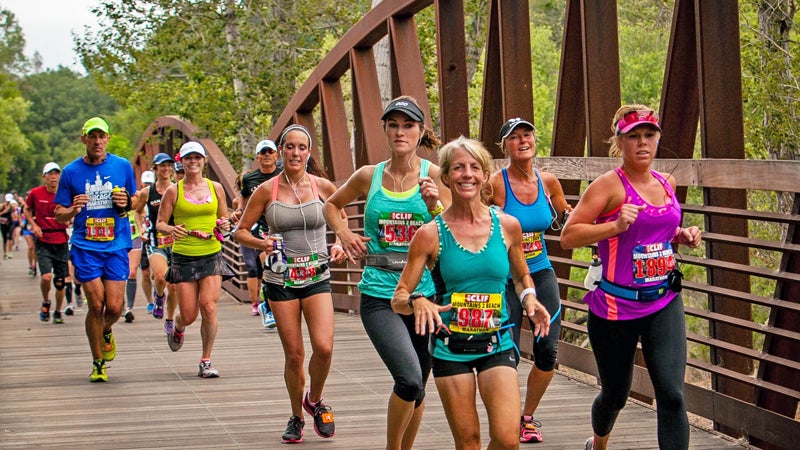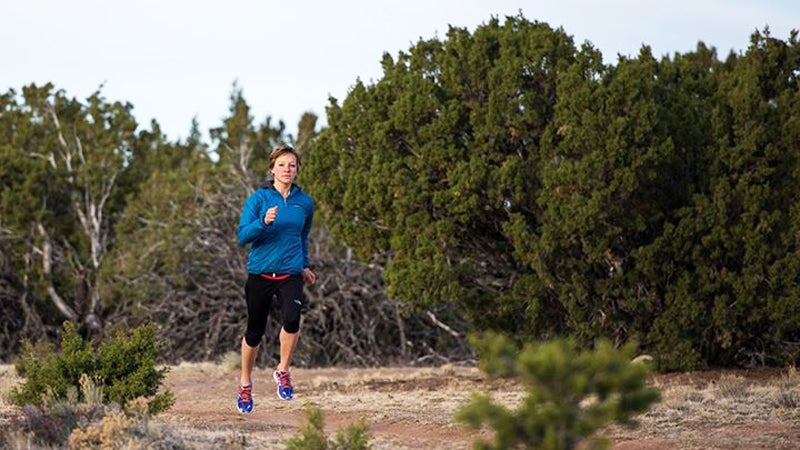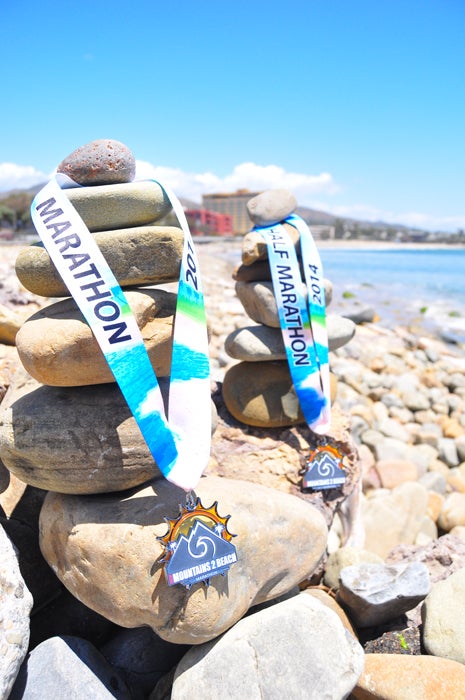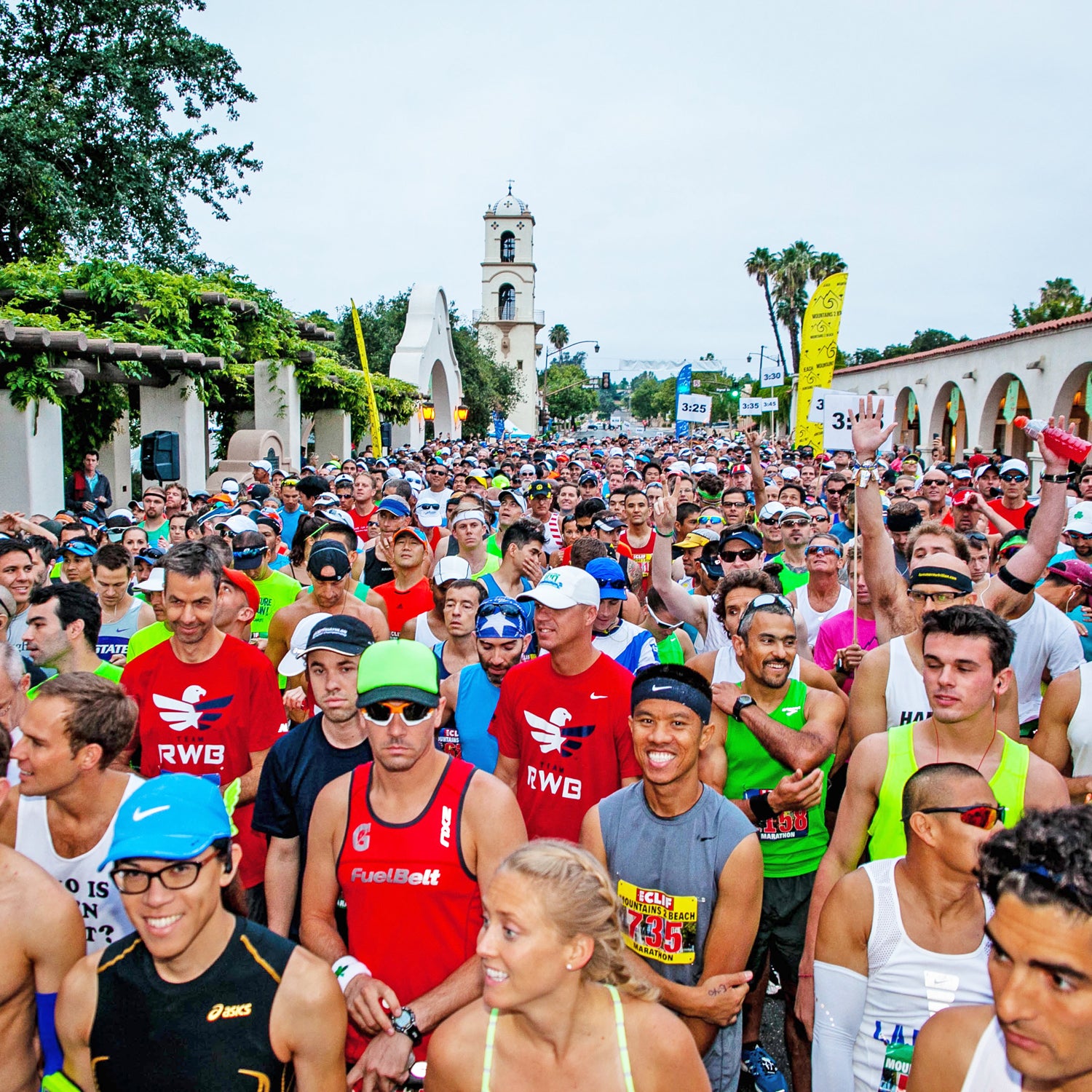It wasn’t exactly clear how far I’d stepped outside my comfort zone until I arrived at the starting line of the Mountains2Beach marathon in Ojai, California, just before 6 a.m. on May 25. While trying to set my pace watch amidst the sea of runners, an error message flashed across the screen: “multiple heart rate monitors detected, cannot calibrate.” Shit. I thought. This is exactly what I need right now.
I signed up to run my first road marathon with one goal in mind: learn how to run fast. And yes, I’m aware of the irony. Twenty-six point two miles is typically a culminating distance goal for many runners.
But it wasn’t so much finishing that worried me. I’d been running ultramarathons somewhat competitively for the past two years, skipping over the 26.2-mile distance and heading straight for 50-mile races. And I’d mostly figured out how to suffer through long days and lonely training hours for the rewards of gorgeous trails and lots of ice cream. But after dropping out of a 100-mile race in France the previous summer, I needed some new motivation to train again. And because speed (going faster than eight minutes per mile for long distances) has always been my weakness, it seemed like a good idea to see if I could train to run faster.
It’s an old school mantra of athletic preparation, particularly in an era of marketed shortcuts, but the best athletes will tell you that in order to succeed, you need to practice your sport and practice it often. In other words, in order to run fast, you need to practice running fast. It’s a straightforward solution to a much more complicated problem, because although speed is a formula that essentially comes down to three basic things—number of foot strikes, cadence of foot strikes and power of each of those foot strikes—speed is a far less simple combination of art, science, and innate genetics.
Genetics of course, are tricky. You can augment the machine you’re born with, but you can’t actually change your DNA. And some people are simply born with more speed potential than others, a topic to which David Esptein devotes an entire chapter to in his 2014 book The Sports Gene. By his count, the world’s top competitive 60-meter sprinters are almost always short because short legs and lower mass make for fast accelerators. The highest concentration of elite track and field athletes comes from three countries—Jamaica, Ethiopia and Kenya—with sprinters dominating the first and distance runners dominating the rest.
Some people are born with a greater concentration of fast-twitch muscle fibers, which contribute to speed over a short amount of time. And there’s even a specific gene, ACTN3, or the so called “speed gene,” which tells muscles to contract and fire rapidly, that has come to be an associated predictor of athletic performance. It’s not the only predictor, by any means, but at least among the elite, it does come in to play.
Yet genetics alone might be overrated. Which is good news if you happen to be predisposed to running long distances, slowly. Ongoing studies by exercise physiologists have shown that it’s actually ground contact, not heart rate or V02 max, that stands out as the better predictor of speed potential. Brad Hudson, author of Run Faster from 5K to the Marathon, explains that training for speed really comes down to how well you can learn to move. “Regardless of the event, if you can improve your running economy, in other words, learn to move better, you’re going to be better at that event.”
And luckily, learning to move better is something that can be trained. That’s the reason why, six weeks before race day, I called Scott Jurek for some advice because I figured he’d understand where I was coming from. After all, Jurek, who is famous for his epic long-distance wins such as Badwater and Western States, also clocked a 2:38 at the Austin Marathon in 2006.

Somewhat arbitrarily I’d settled on a goal of running a 3:30 marathon, though I didn’t actually have much on which to base this number. With previous races as indicators, it’s possible to calculate an estimated marathon time using tools such as the McMillan Running Calculator. But up to this point I had only one actual road race to my name, a half marathon I’d run on a whim back in college, long before I actually considered myself a “runner.”
I know my split times for most of the ultras I’ve competed in, but those don’t translate well to roads (when you’re going up a mountain at four miles per hour, and barreling down the other side at ten, your splits are all over the place). Still, 3:30 seemed reasonable. I knew I could run the required average of 8:10 miles comfortably enough at altitude (Outside’s high-desert headquarters are at 7,000 feet). Plus, I was quietly banking on the advantage I’d get racing at sea level—more than 1.3 miles lower.
After listening patiently to my speed anxiety, Jurek recommended I focus less on track workouts or even long slow days, both a part of many standard marathon training plans, and instead direct the majority of my attention toward tempo runs, which demand the most from your muscles.
“Trail runners love not worrying about numbers,” he told me. “But numbers are a good thing to monitor if your goal is to improve your speed.” Jurek prescribed a healthy dose of tempo and threshold workouts—like running six to nine miles at my goal race pace with a warmup and cooldown, or 15-20 minutes at five to 10 seconds faster per mile than race pace, or 5-to-1 speed drills, with five minutes of high intensity and one minute of low intensity running to get used to having more acidity in my blood.
My eyes were glazing over. That’s a lot of numbers to digest. But I was already trading trails for concrete bike paths so placing focus on a pace watch rather than tricky terrain seemed like the next step. “Plus,” Jurek reminded me, “an early season road marathon will only help your ultra times.”

The first thing I learned about trying to run fast is that it’s incredibly uncomfortable. Unlike ultras, where the goal is basically to find a pace you can hold consistently for 50 to 100 miles, training for speed is often about finding the most vexatious threshold you can reach and trying to hold that for as long as you possibly can. At least, that’s how it felt in the beginning.
With just over a month to go, I decided to do tempos twice a week, alternating between Jurek’s suggestions and adding a few others from various marathon training guides I’d found online, including a modified version of Hal Higdon’s Intermediate plan. I also ran a handful of long runs building up to 22 miles on the weekends with another Outside editor who happens to be frustratingly faster than me. I even got over my fear of running with the boss and started tagging along on daily lunch runs.
And though it didn’t feel like it at first, I was getting faster. Not record breaking fast, but eight-minute miles started to feel easy, and tempo runs no longer tasted like pennies, and the split times on my pace watch were speedier and more sustained than they’d been at the beginning of this experiment. It was the first time I’d ever methodically trained for running, and though I missed the freedom of running without I watch, I appreciated the structure. And then it was time to start tapering.
On the morning of the race I was up at 4 a.m., enough time to digest a Clif Bar and a few bites of banana and get my race kit in order. The scene in downtown Ojai was unlike anything I’d ever seen before the start of a race. Hundreds of runners calibrating their watches, jogging warm-up laps and waiting in endless lines for porta-potties while pace groups started to form inside the queue.
I joined a handful of runners who’d decided to use the public park as a bathroom (sorry, Ojai), then made my way to the start line, pushing just ahead of the 3:30 group so as not to get stuck in the stampede. The problems with my pace watch were sending me into a mild state of panic, but at the last minute I managed to get a satellite reading, just in time for the gun.
I’d like to tell you that running a marathon is just as peaceful and inspiring as running an ultra. I’d like to tell you that after the first mile, all races are the same: you fall into a familiar rhythm and the whole mental and physical approach is basically the same. But I’d be lying.
All I could think about were numbers. After realizing an 8:10 minute mile felt way too easy in the syrupy sea level air, I picked up the pace to see how 8:00 felt. Still easy, I went for 7:30. A little harder, but I was already almost two miles in. 7:10 it was. Pretty soon I was directly between two pace groups, the 7:00s and the 7:15s. And this is pretty much where I stayed for the rest of the race, though I slowed slightly in the second half.

Things started to hurt around mile 18, but I’d been warned that would happen. So instead of looking at my watch, I started reading the signs held by spectators for other racers. “You can do this!” in pink puffy paint. “I can do this!” I thought, wincing at how corny it sounded in my own head. I broke the remainder of the race up into pieces. “Eight miles to go, that’s like a lunch run to the reservoir. Six miles to go, you’ve already done that three times today. Three miles to go, this thing is almost over” and so on.
With one mile to go, something shifted in my brain. One mile was nothing. If I sprinted, I could break 3:10. So I did, passing a few runners in the final stretch and crossing the finish line at 3:09:46. Someone told me later that my finish line exclamation of “It’s over already?” was probably the first in the history of marathons.
Even though they’re shorter, 26.2 miles still hurts. In some ways those miles hurt worse than an ultra because unlike in longer trail races where there’s some relief in the form of aid stations or big hills; in a marathon, you never get to feel comfortable. But you’re also finished in time to eat a second breakfast and swim in the ocean and enjoy the fact that at least this time, you’ve trained enough to obliterate your goal time.
Which is exactly what I did. And though I’ll always be a trail runner at heart, I’m sort of thinking about running another…


